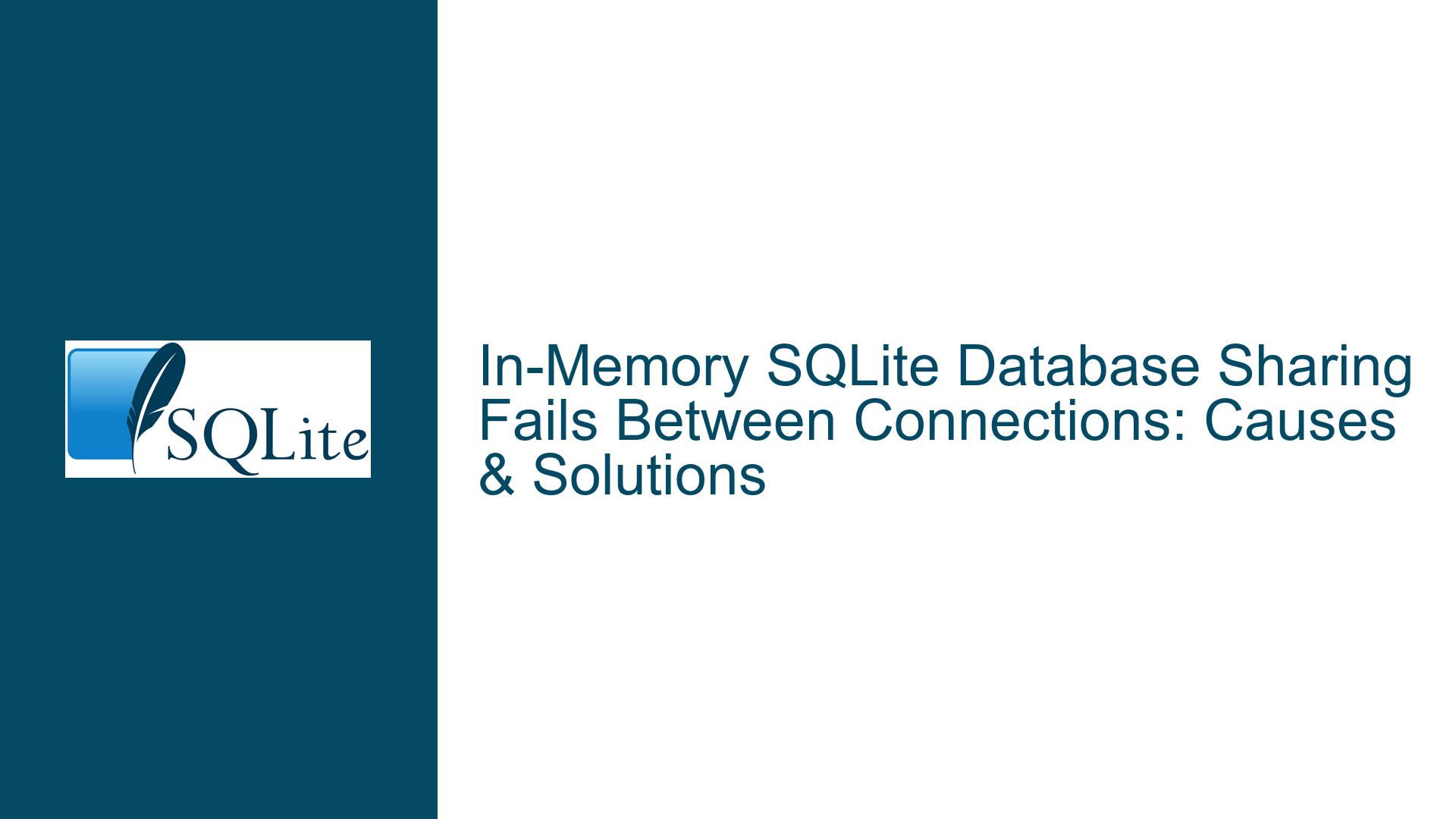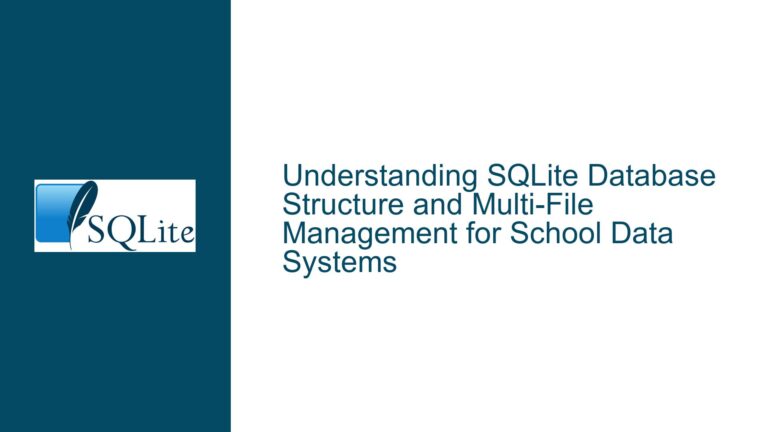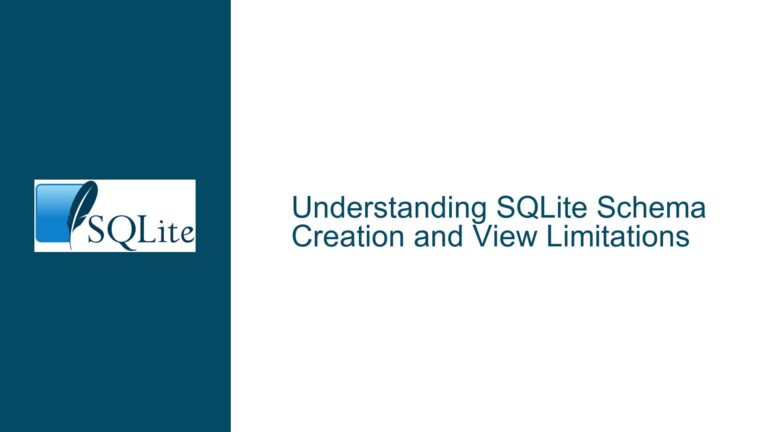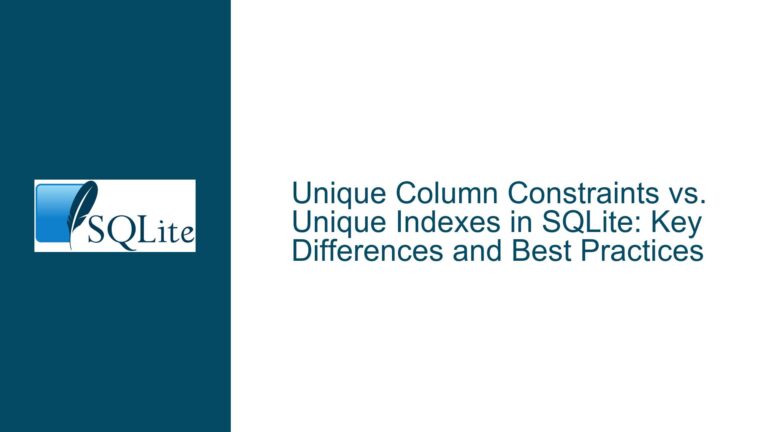In-Memory SQLite Database Sharing Fails Between Connections: Causes & Solutions
Issue Overview: Shared In-Memory Database Not Accessible Across Connections
When attempting to share an in-memory SQLite database between multiple connections within the same process, developers may encounter unexpected errors indicating that tables or schema objects created in one connection are not visible in another. This issue arises specifically when using URI-based connection strings with parameters like mode=memory and cache=shared, which are designed to enable cross-connection sharing of in-memory databases.
For example, consider a Lua script that opens two connections to an in-memory database named memdb1 using the URI file:memdb1?mode=memory&cache=shared. The first connection creates a table foo and inserts data, which is confirmed to exist via a query. However, the second connection fails to recognize the table’s existence, returning a "no such table: foo" error. This behavior contradicts the expected functionality of shared in-memory databases, where schema changes and data modifications should be visible across all connections referencing the same named in-memory database.
The problem is particularly prevalent in SQLite versions prior to 3.36, where alternative methods (e.g., the memdb VFS) are required for reliable cross-connection sharing. Even in newer versions, subtle configuration errors in URI parameters, connection flags, or wrapper libraries can lead to failures.
Possible Causes: Why In-Memory Database Sharing Fails
The inability to share an in-memory database between connections can be attributed to several factors, often interacting in non-obvious ways. Below are the most common root causes:
1. SQLite Version Limitations
SQLite’s handling of shared in-memory databases evolved significantly in version 3.36 with the introduction of the memdb VFS (Virtual File System). Prior to this, the mode=memory&cache=shared URI parameters relied on the default VFS, which had inconsistent behavior for in-memory database sharing.
- Pre-3.36 Behavior: The
cache=sharedparameter alone was insufficient to guarantee proper sharing. The default VFS treated in-memory databases as process-global only under specific conditions, often requiring additional flags or workarounds. - Post-3.36 Behavior: The
memdbVFS explicitly supports named, shared in-memory databases via URIs likefile:memdb1?vfs=memdb, bypassing ambiguities in the default VFS.
If the SQLite library linked to the application is older than 3.36, attempts to use mode=memory&cache=shared may fail silently, as seen in the original example.
2. Incorrect URI Syntax or Parameter Handling
The URI format for connecting to shared in-memory databases is highly sensitive to syntax errors and parameter ordering. Common pitfalls include:
- Missing or Misplaced Parameters: Omitting
mode=memoryorcache=sharedinvalidates the sharing mechanism. For example, usingfile:memdb1?cache=sharedwithoutmode=memorycreates a shared on-disk database instead. - Improper VFS Selection: In versions where
memdbis available, failing to specifyvfs=memdbforces the connection to use the default VFS, which may not support cross-connection sharing. - URI Encoding Issues: Special characters in URIs (e.g., spaces) must be percent-encoded. While not directly applicable to the example, improper encoding can lead to unrecognized database names.
3. Wrapper Library or Driver Limitations
SQLite wrapper libraries (e.g., lsqlite3 in Lua, sqlite3 in Python) abstract low-level connection handling, but they may not fully propagate URI parameters or flags to the SQLite core.
- Incomplete Flag Propagation: The
OPEN_URI,OPEN_READWRITE, andOPEN_CREATEflags must be explicitly passed tosqlite3_open_v2(). If the wrapper fails to do so, URI parameters are ignored, and the database is treated as a private in-memory instance. - Shared Cache Misconfiguration: Some wrappers enable or disable shared cache mode globally, conflicting with per-connection URI settings. For example, using
OPEN_SHAREDCACHEas a connection flag without enabling URI handling can lead to undefined behavior.
4. Concurrency and Isolation Misunderstandings
Shared in-memory databases do not inherently provide transaction isolation or locking across connections. Concurrent writes from multiple connections can lead to database locks or corruption if not properly managed. However, the original issue—where a table is entirely invisible—is unrelated to concurrency and points to a deeper configuration problem.
Troubleshooting Steps, Solutions & Fixes
Resolving issues with shared in-memory databases requires a systematic approach to isolate the root cause. Below are actionable steps to diagnose and fix the problem.
Step 1: Verify SQLite Version and Features
Action: Check the SQLite version using sqlite3.sqlite_version (in Lua) or SELECT sqlite_version();.
If the version is < 3.36:
- Upgrade to SQLite 3.36+ to access the
memdbVFS, which simplifies shared in-memory database creation. - If upgrading is impossible, use the workaround described in Step 4.
- Upgrade to SQLite 3.36+ to access the
If the version is ≥ 3.36:
- Confirm that the
memdbVFS is available by executing.vfslistin the SQLite CLI. If absent, recompile SQLite with-DSQLITE_ENABLE_MEMDB_VFS.
- Confirm that the
Example:
local sqlite3 = require "lsqlite3"
print("SQLite version:", sqlite3.sqlite_version())
Step 2: Validate URI Syntax and Connection Flags
Action: Ensure the connection URI and flags are correctly formatted.
Required Parameters:
mode=memory: Explicitly declares the database as in-memory.cache=shared: Enables shared cache mode for the database.vfs=memdb(optional but recommended in 3.36+): Forces the use of thememdbVFS.
Correct URI Examples:
- Pre-3.36:
file:memdb1?mode=memory&cache=shared - Post-3.36:
file:memdb1?vfs=memdb
- Pre-3.36:
Required Flags:
OPEN_URI: Enables URI-based connection strings.OPEN_READWRITE: Allows read/write access.OPEN_CREATE: Creates the database if it does not exist.
Example Fix:
-- Lua example with explicit flags and URI parameters
local flags = sqlite3.OPEN_URI + sqlite3.OPEN_READWRITE + sqlite3.OPEN_CREATE
local dbm1 = sqlite3.open("file:memdb1?vfs=memdb", flags)
Step 3: Diagnose Wrapper Library Behavior
Action: Test the same URI and flags in the SQLite CLI or another language (e.g., Python) to isolate wrapper-specific issues.
- Using the SQLite CLI:
# Open first connection
sqlite3 "file:memdb1?vfs=memdb"
sqlite> CREATE TABLE foo(k PRIMARY KEY, a TEXT);
sqlite> .quit
# Open second connection
sqlite3 "file:memdb1?vfs=memdb"
sqlite> SELECT * FROM foo; -- Should return no error
- Using Python:
import sqlite3
conn1 = sqlite3.connect("file:memdb1?vfs=memdb", uri=True)
conn1.execute("CREATE TABLE foo(k PRIMARY KEY, a TEXT)")
conn2 = sqlite3.connect("file:memdb1?vfs=memdb", uri=True)
cursor = conn2.execute("SELECT * FROM foo")
print(cursor.fetchall()) -- Should return []
If the CLI or Python examples work but the Lua script fails, the issue lies in the lsqlite3 wrapper.
Step 4: Workarounds for Older SQLite Versions (< 3.36)
Action: Use alternative methods to share in-memory databases when upgrading is impossible.
Method 1: Shared Disk-Based Database
Approach: Use a temporary on-disk database with mode=memory omitted. While not purely in-memory, this allows cross-connection sharing.
Example:
local dbm1 = sqlite3.open("file:tempdb?cache=shared", flags)
local dbm2 = sqlite3.open("file:tempdb?cache=shared", flags)
Drawback: The database is written to disk, impacting performance and requiring cleanup.
Method 2: Single Connection with Attached Databases
Approach: Use a single connection and attach in-memory databases as needed.
Example:
local db = sqlite3.open(":memory:", flags)
db:exec("ATTACH DATABASE 'file:memdb1?vfs=memdb' AS shared")
db:exec("CREATE TABLE shared.foo(k PRIMARY KEY, a TEXT)")
Limitation: All operations must occur through the primary connection.
Step 5: Debugging Connection Flags in Wrappers
Action: Inspect the wrapper’s source code to ensure flags like OPEN_URI and OPEN_SHAREDCACHE are correctly passed to sqlite3_open_v2().
Critical Code Snippets:
- The
sqlite3_open_v2call must includeSQLITE_OPEN_URIto enable URI parsing. SQLITE_OPEN_SHAREDCACHEmay be required in addition tocache=sharedin some configurations.
Example Fix in C:
// Ensure flags include SQLITE_OPEN_URI and SQLITE_OPEN_SHAREDCACHE
int flags = SQLITE_OPEN_READWRITE | SQLITE_OPEN_CREATE | SQLITE_OPEN_URI | SQLITE_OPEN_SHAREDCACHE;
sqlite3_open_v2("file:memdb1?mode=memory&cache=shared", &db, flags, NULL);
Step 6: Handling Concurrency and Cache Conflicts
Action: Avoid concurrent schema modifications or writes to shared in-memory databases. Use mutexes or application-level locks to serialize access.
Example:
local mutex = require "sys.mutex"
local mtx = mutex.new()
mtx:lock()
dbm1:exec("CREATE TABLE foo(...)")
mtx:unlock()
mtx:lock()
dbm2:exec("SELECT * FROM foo")
mtx:unlock()
Final Solution Summary
- Upgrade to SQLite 3.36+ and use
vfs=memdbfor reliable in-memory sharing. - Use Correct URI Syntax:
file:memdb1?vfs=memdb(3.36+) orfile:memdb1?mode=memory&cache=shared(pre-3.36). - Validate Wrapper Configuration: Ensure
OPEN_URIandOPEN_SHAREDCACHEflags are passed. - Test with CLI/Python to isolate wrapper-specific bugs.
- Fallback to Disk-Based Sharing if in-memory sharing is unattainable.
By methodically addressing version constraints, URI parameters, and wrapper limitations, developers can successfully share in-memory databases across connections in SQLite.






